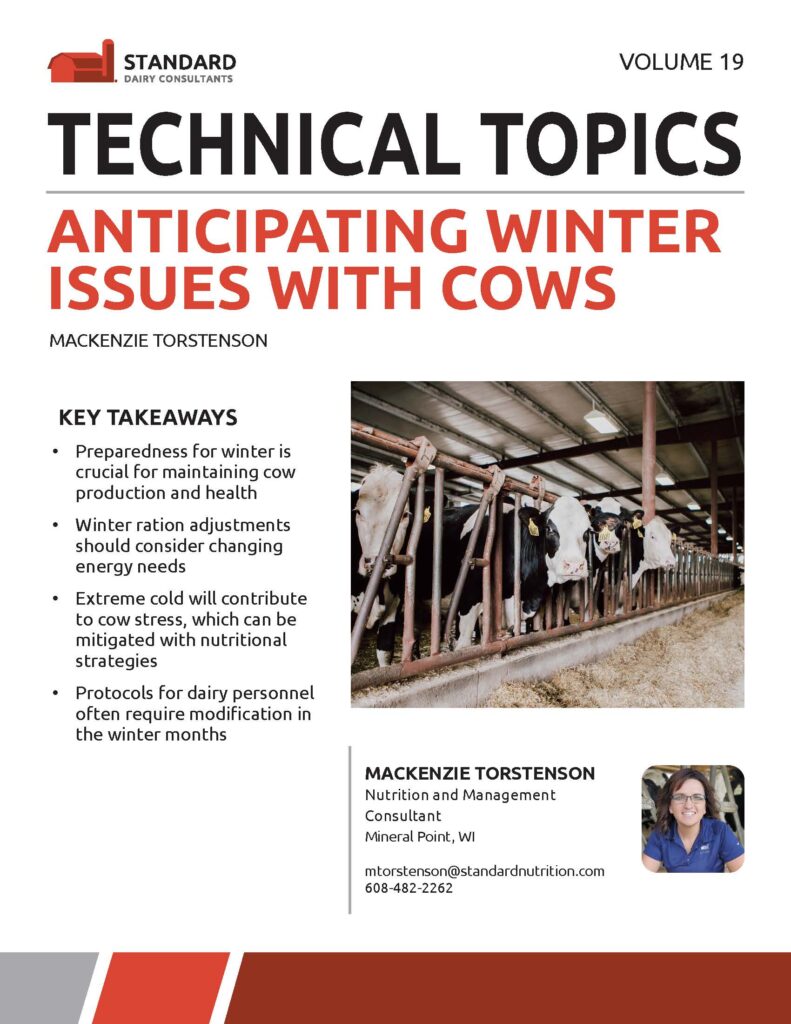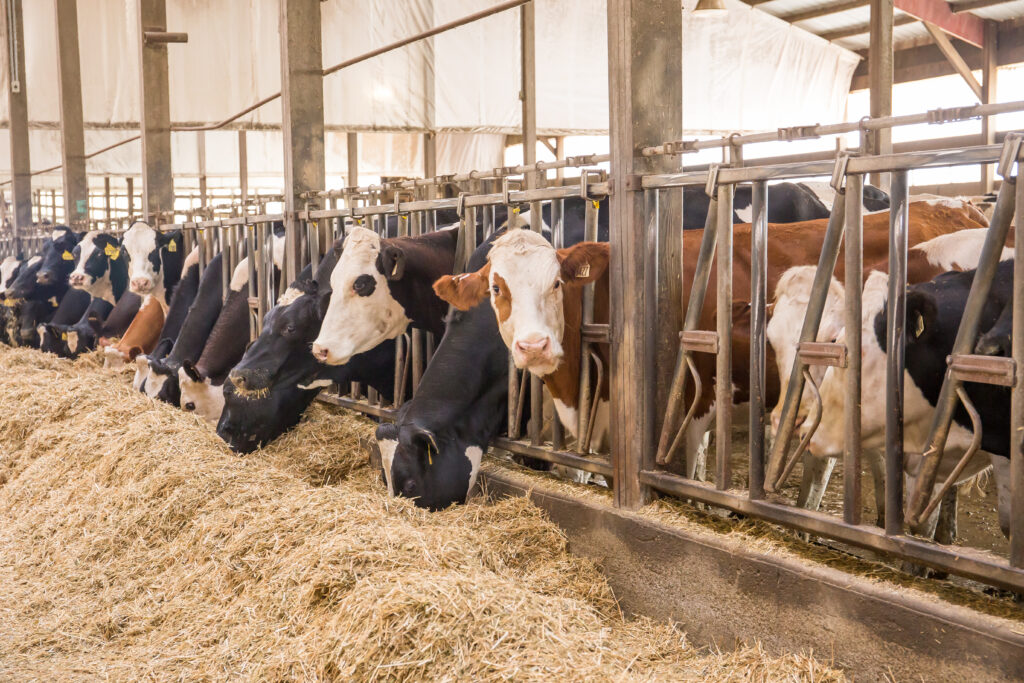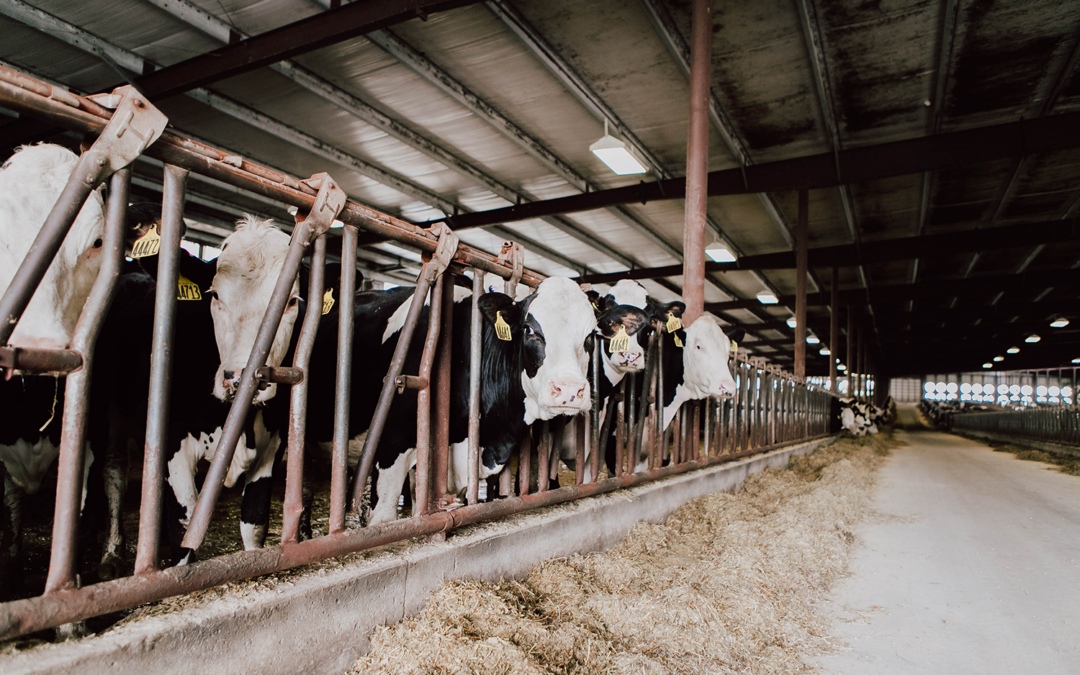Written by: Mackenzie Torstenson
KEY TAKEAWAYS IN THIS ISSUE OF TECHNICAL TOPICS:
- Preparedness for winter is crucial for maintaining cow production and health
- Winter ration adjustments should consider changing energy needs
- Extreme cold will contribute to cow stress, which can be mitigated with nutritional strategies
- Protocols for dairy personnel often require modification in the winter months

Being prepared for every situation that life throws our way always seems to bring a sense of comfort and confidence. Winter for a dairy producer may be the most significant time when being ready is a multi-faceted array of complicated scenarios. Each producer runs through their checklists of feed inventories, winterization of equipment, extra supplies, and building maintenance long before the temperatures start to creep down or the first snowflake flies. But in the preparation of it all, are we, as producers and trusted advisors, doing our part to include the herd in the arrangements as well?
Many times, if anyone was asked that question, the response may indicate that all of the items on the original checklist indirectly pertain to the herd and its readiness for winter to settle in. Is there more to it than that? Are there other ways we can devise a checklist to directly prepare the cows themselves for what may lie ahead during the coldest months of the year?
Three specific areas to consider adding to the winter checklist are discussed below:
WINTER RATION ADJUSTMENTS
The most significant component to understand is the animals themselves. Recognizing that diet changes need to occur to meet the cow’s needs is essential. During the winter, the energy needs of the cow rise drastically. She is not only focused on working hard to produce milk but now, due to cold temperatures and the calories being burned for her to thermoregulate, it is essential that we increase the energy density of the diet to not only help her regulate her body temperature and keep her producing accordingly but also to help her maintain body condition. Body Condition Scoring is an excellent tool to utilize in all seasons, especially at the start, during, and end of winter. We want the cow to start and finish her lactation at the same condition score, so periodically observing how well the pen is holding, losing, or gaining is a critical way to help predict and plan for success. Dry cows, in particular, are one group that watching body condition score closely is needed. During the winter months, when cows develop thicker coats, it is easy to have weight loss go unnoticed.
During the dry period, while the cow is already working hard to finish developing the calf and start producing colostrum, weight loss can negatively affect the success of the animal herself and her calf. Ensuring the dry cow is maintaining a 3.25 body condition score while consuming a well-balanced, energy-adequate diet helps keep her on the path to success and lowers the risks of issues post-calving.

WINTER STRESS MITIGATION AND PREVENTION
Stress is also a significant nemesis to a dairy cow, especially as she works through what many argue is the most demanding season of the year. If her diet is not balanced to combat elemental factors, the stress load can grow and cause the immune function to be compromised. Producers should be encouraged to consider adding high-quality options that may help boost immune function to keep herd health tip-top. Simplistic pieces may be raising vitamin levels or adding a yeast product to help increase rumen function.
When stress gets in the way, fighting off scenarios such as winter dysentery can be much more costly to the dairy, not only from a treatment standpoint, but also on revenue loss vs. the investment of slightly increased diet costs to prevent issues from occurring.
WINTER PERSONNEL MANAGEMENT AND PROTOCOLS
Managing cow stress does not just stop at increasing immune function, however. Looking at all gamuts of the spectrum are needed and planning how we will manage them on and off the farm is key. How well are faces being managed on bunkers? Is there any heating occurring? Are we managing dry matters appropriately to keep diets correct and consistent despite potential weather-related issues which will add moisture to the forages? Keeping the diet accurate, clean, and consistent will help mitigate stress. If a diet’s accuracy is constantly questioned, stress will follow. Making sure that there are plenty of push-ups occurring, beds are being groomed well, and post-milking prep is being done correctly are also pieces of the puzzle that help lower stress load. Ensuring that each dairy team has protocols to help manage these scenarios is needed.
As consultants, it is our responsibility to work with each dairy to see all planning and preparation come to fruition. Progressively identifying potential problem areas long before they become problematic is essential. Again, developing a cow-specific winter prep checklist is a great way to prepare the dairy for what lies ahead to ensure that we not only are ready for winter, but so are the cows.
WINTER PREP CHECKLIST
- Have diet updates been made?
- Are we adding in additional immune support pieces?
- Has our consultant increased the energy density of the diet?
- What is the current Body Condition Score of the pens?
- How often will the plan to BCS them throughout the season?
- What are we looking for as an ideal score in each pen?
- Should we see gains, losses, or maintenance of BCS according to the stage in lactation?
- How will the dairy mitigate stress for the animals?
- Is our designated mixing individual prepared and trained to manage faces on bunkers, moistures, and accuracy of diets appropriately?
- Are barn employees trained and ready to groom stalls more often to reduce stress of frozen, uncomfortable beds?
- Do we have a high-quality post dip in stock on the dairy, and have we worked with the milker team to ensure teats are being dipped appropriately to reduce chances of udder stress issues?
Perspective on Teams
Written by: Dan Illg, PhD
What is the purpose of a team? The adage that Together Everyone Accomplishes More is what comes to mind. The accomplishments over what the individuals could accumulate on their own are increased. Who are the people on the team? The easy answer is the front-line players that are hands-on with the day-to-day tasks of the dairy. Additionally, the people behind the scenes that are supporting the team are a critical component. Imagine a sports team without a reliable equipment manager or transportation department. A good support group of managers and advisors allow the team to focus on the priorities of the dairy.
There is a need for trust among those that are striving for a common cause. With trust, many obstacles can be overcome. Without trust, accomplishing the necessary tasks is nearly impossible over the long haul. If a team member disappoints, find out why. People do not go out on a regular basis with the goal of disappointing others; they are likely acting with what they perceive as good intentions. Seeking to understand their perspective builds trust.
A lack of communication can degrade trust more quickly than almost anything else. Communication must be a top priority so that all people involved are tuned into what is happening. Keeping all parts of the team informed is essential in all aspects of planning to meet the prescribed needs and commitments of the dairy. If communication is clear and routine, it will not be foreign during times of stress. Assumptions that everyone knows what to do and when will lead to disappointment and discontent. When the heat is on, this is not the point to initiate communication, as this messaging often is more damaging than the situation that caused the problem in the first place.
To succeed as a team, own the problems as a team, be humble, listen to each other, listen to employees, lead with good examples, and have regular debriefs on what has occurred. These debriefs could include all those that play a role in the team’s performance.


